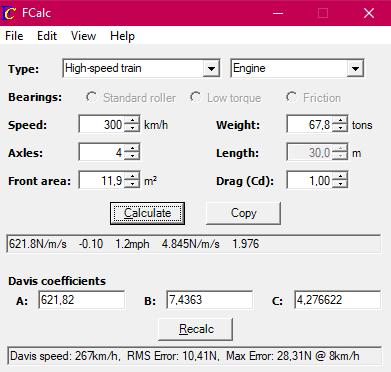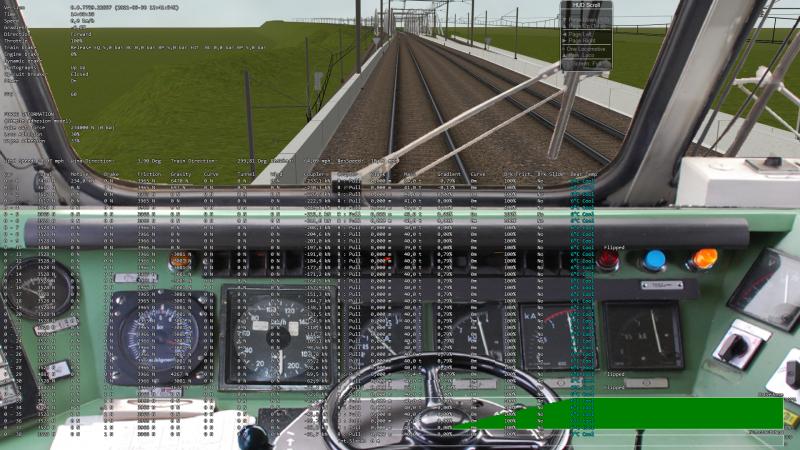Problem with long trains ( record consists ) Train wil not depart
#1

Posted 06 April 2021 - 04:13 AM
In Belgium & Holland there have been made consists for do record (longest passenger train of the world).
Holland have do this with 60 passenger cars, In Belgium we have do this with 70 passenger cars.
In Openrails train wil not moving. ( Brakes are full released, .eng/.wag files are ok )
First i was think that it was becauze of friction so i have use:
ORTSStandstillFriction ( 3400 )
ORTSMergeSpeed ( 0.869698 )
ORTSBearingType ( Friction )
on it.
1 car have a weight of +/- 40tonnes
From the Belgium version i know that he have 1hour driving with speed of 80km/h
If i uncouple cars too fifty/fifty of this train = 35 cars than he will depart realy slowly.
On old movie of this depart in Real for this Class 27 it was no problem to pull this train.
In OpenRails it is 234kN & 4380kW => 0km/h. :-(
When i have download the Holland cars befor i have update .wag files with right weights ( 41t ) the train was moving, but that comes becauze MSTS engineering was do with weight of 27t.
With right values in case weight this train wil not moving too :-(.
I have this test with and without ORTSTractiontable too.
The real weight of Belgian record train was 2786tonnes
I hope someone have solution for this.
#2

Posted 06 April 2021 - 05:43 AM
#4

Posted 06 April 2021 - 07:32 AM
ORTSStandstillFriction ( 3400 )
to:
ORTSStandstillFriction ( 10 )
And now the train departs :-)
But what is best way to calculate ORTSStandstillFriction?
For:
ORTSDavis_A ( 1051.39 )
ORTSDavis_B ( 27.6402 )
ORTSDavis_C ( 0.475130 )
ORTSBearingType ( Roller )
I use Fcalc
Friction of MSTS is not exist on my .eng/.wag files with ORTSDavis values.
For ORTSStandstillFriction & ORTSMergeSpeed i want know best way for get values that match with real realism.
In my case is this for European locomotives & railcars.
In advance thanks,
Stijn
#5

Posted 07 April 2021 - 03:18 AM
ORTSStandstillFriction ( 854.407009 )
ORTSMergeSpeed ( 0.232751 )
In this setup the presence of ORTSBearingType ( Roller ) is not neccesary as it is overwritten.
This should bring the starting resistance of the whole train to something about 58-65kN which is possible to start with 234kN tractive force.
For more information consider downloading the friction calculator made for these lines, available here at ET/utilities.
#6

Posted 09 April 2021 - 02:32 PM
 NickonWheels, on 07 April 2021 - 03:18 AM, said:
NickonWheels, on 07 April 2021 - 03:18 AM, said:
ORTSStandstillFriction ( 854.407009 )
ORTSMergeSpeed ( 0.232751 )
In this setup the presence of ORTSBearingType ( Roller ) is not neccesary as it is overwritten.
This should bring the starting resistance of the whole train to something about 58-65kN which is possible to start with 234kN tractive force.
For more information consider downloading the friction calculator made for these lines, available here at ET/utilities.
Hello,
I have found ORTS friction program on this forum, and i have update most of my .wag files and .eng files with this program.
You know this program, because it is from you (youre post ) :-)
Before i was use Fcalc, but Fcalc only gives Davis ABC and MSTS friction.
Now that train drives up too more of 100 km/h :-) after 40km, so that is good.
In real they have not reach the 80km/h and reostatic brake was disabled too. ( speedlimits, and security, imporant was too, that locomotive gives 1houre traction too for this record.
#7

Posted 09 April 2021 - 08:30 PM
A train using link coupling (most all in Europe) is effectively rigidly coupled, meaning the entire train must start as the engine(s) start to move.
In America all couplers except passenger trains have built in slack making sense of the answer the BNSF engineer (driver) gave me when I asked her,"How do you start a heavy freight train?"
Her answer was "One car at a time"
I've watched a lot of driver views of European trains and the one thing that interested me was I've never seen a freight consist in Europe exceeding 50 wagons! Fact is most European freight consists I've viewed were 25 to 35 wagons.
This makes sense when considering the type of coupling used. Link coupling = no slack. This seriously limits train length..
I don't 'know' if the link couplers (no slack ) are in use in all countries but MSTS did indeed make allowance for them in the wag file parameter:
CouplingHasRigidConnection – set this to 1 for wagons that have rigid, rather than flexible couplings. ref:MSTS Tech Docs
regards,
vince
regards,
vince
#8

Posted 09 April 2021 - 11:32 PM
For trains that exceed the maximums of the screw coupler an automatic coupler is used (C-AKv), this is less prone to breaking, but I am not sure if it allows for slack to happen.
So, in short, it is not because the link couplers don't allow for slack, it is because of the crowdedness of the network, and because link couplers can create serious havoc if they are slacked.
#9

Posted 10 April 2021 - 05:32 AM
Here is another alternative friction calculator. It does not offer starting friction, but it allows you to choose from a range of alternative values used by different railways depending on the type of vehicle.
Friction Calculator
It also includes a document detailing published measurements of resistance from different countries.
There are none specifically from Holland or Belgium, but these are from France (M is mass in tonnes):
For Passenger Carriages on Bogies (Profilidis)
ORTSDavis_A = 14.7 M
ORTSDavis_B = 0
ORTSDavis_C = 0.0282 M
For Standard UIC Passenger Carriages (Allenbach et al)
ORTSDavis_A = 15 M
ORTSDavis_B = 0
ORTSDavis_C = 0.0272 M
For Standard UIC Passenger Carriages (Profilidis)
ORTSDavis_A = 12.3 M
ORTSDavis_B = 0
ORTSDavis_C = 0.0202 M
For Corail Passenger Carriages (Allenbach et al)
ORTSDavis_A = 12.5 M
ORTSDavis_B = 0
ORTSDavis_C = 0.0194 M
From Swiss Railways:
For Voiture légère Passenger Carriages:
ORTSDavis_A = 14.7 M
ORTSDavis_B = 0.154 M
ORTSDavis_C = 0.0278 M
#10

Posted 10 April 2021 - 07:07 AM
Is it correct that link is broken? => [#10850] An internal error occurred. Please contact an administrator
Maybe you know the Eurostar TMST ( Class 373 )
With ORTS Friction i get this values: ( Motorcar Front/Back )
comment ( 67.8 metric tons / 4 axles / 11.9064 square meters )
ORTSDavis_A ( 974.602044 )
ORTSDavis_B ( 8.111936 )
ORTSDavis_C ( 1.426268 )
ORTSStandstillFriction ( 1130.317955 )
ORTSMergeSpeed ( 0.261022 )
ORTSBearingType ( Low )
With Fcalc:

+ Point with Fcalc is that you can select for what you need data, in this case High Speed train.
- point is that you can not use many numbers after decimals like ORTS friction can be do.
With ORTSDavis_A ( 974.602044 ) it is hard to get 300km/h on 0% profile
With ORTSDavis_A ( 621.82 ) i get this 300km/h on aceptabel time ( TMST in Belgium have 18 passengercars on it, so it is normal that it needs time for get 300kmh )
Greetz,
Stijn
#11

Posted 10 April 2021 - 07:19 AM
 vince, on 09 April 2021 - 08:30 PM, said:
vince, on 09 April 2021 - 08:30 PM, said:
I don't 'know' if the link couplers (no slack ) are in use in all countries but MSTS did indeed make allowance for them in the wag file parameter:
CouplingHasRigidConnection – set this to 1 for wagons that have rigid, rather than flexible couplings. ref:MSTS Tech Docs
regards,
vince
regards,
vince
The "CouplingHasRigidConnection" setting is recommended for multi-part multiple units such as KISS, FLIRT. In the past, the rear and front car switches could also be set with the MSTS. In the assembly, the vehicles used the "Bar" setting with each other, with the "CouplingHasRigidConnection" modifier, and the "Automatic" setting at the two extremes, also with the CouplingHasRigidConnection "modifier.
I’m not sure, but OR no longer supports that.
Greetings: Laci 1959
#12

Posted 10 April 2021 - 01:16 PM
http://www.elvastowe...culator-for-or/
For the Class 373 these are the total values for a trainset from a research paper
For Eurostar Class 373 20-car 2+18 M=867 L=394 (Rochard):
ORTSDavis_A = 6550
ORTSDavis_B = 82.0
ORTSDavis_C = 23.9
Which to my own mind looks a very high value for ORTSDavis_C
The values given by others for TGV resistance is much lower
For TGV -POS set M=427 (Jernbanverket):
ORTSDavis_A = 2760
ORTSDavis_B = 198
ORTSDavis_C = 7.41
For TGV -Duplex set M=424 (Alvarez):
ORTSDavis_A = 2700
ORTSDavis_B = 115
ORTSDavis_C = 6.93
For TGV - Réseau set (SYSTRA):
ORTSDavis_A = 2700
ORTSDavis_B = 104
ORTSDavis_C = 6.61
For TGV -Réseau set M=490 (Alvarez):
ORTSDavis_A = 3800
ORTSDavis_B = 140
ORTSDavis_C = 6.61
For TGV -Atlantique set M=416 (Alvarez):
ORTSDavis_A = 2700
ORTSDavis_B = 118
ORTSDavis_C = 7.32
For TGV PSE set (Sjokvist):
ORTSDavis_A = 3900
ORTSDavis_B = 148
ORTSDavis_C = 8.19
For TGV PSE set (Allenbach/Guiheu):
ORTSDavis_A = 2540
ORTSDavis_B = 120
ORTSDavis_C = 7.41
For TGV PSE set M = 418 (Alvarez):
ORTSDavis_A = 2350
ORTSDavis_B = 111
ORTSDavis_C = 6.93
So even allowing for the extra length of the Eurostar I find it hard to believe the ORTSDavis_C should be more than about 12 for the whole train.
#13

Posted 11 April 2021 - 02:33 AM
https://i.imgur.com/MmM7yQc.jpg
ORTSDavis_A ( 678 )
ORTSDavis_B ( 13.6 )
ORTSDavis_C ( 2.32 )
ORTSWagonFrontalArea ( 89ft^2 )
ORTSDavisDragConstant ( 0.00117 )
ORTSTrailLocomotiveResistanceFactor ( 0.355 )
There seems little point in using numbers more accurate than two or three significant figures. If you look at the values different researchers give for the same type of TGV, you will realise that there is a considerable margin of error in different measurements and estimates in the real world.
#14

Posted 11 April 2021 - 05:08 AM
Automatic couplers can be spring(for freight cars) semi-rigid (for passenger cars and old EMUs) and rigid.
https://ru.wikipedia.../%D0%A1%D0%90-3
http://www.modelzd.r...cepka-sa-3.html
https://yandex.ru/vi...987763210879910
#15

Posted 12 April 2021 - 03:13 AM
When coupling together two locomotives of the same type the player engine has higher friction when moving, anything behind has some factor causing a less steep curve. But I observed some different behavior in this.
Once I tried a similar high-speed train where the power cars had the same Davis values but at a certain speed the friction value of the rear power car is even less than the intermediate cars which had smaller Davis values. Can ORTSTrailLocomotiveResistanceFactor enhance this?

 Log In
Log In Register Now!
Register Now! Help
Help









